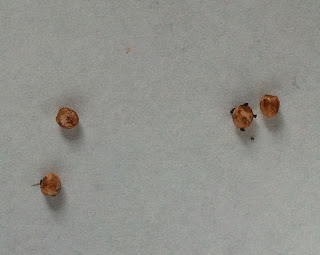 |
| 2nd instar caterpillar above two 1st instar caterpillars |
Lots of updates to share on the 10th day of rearing.
Unfortunately, the small caterpillar that was having trouble clinging to leaves has died. There are now 14 caterpillars. This is still too many for us to feed once they get large, so we are going to have to figure out how to let some people go.
We changed the habitat as a result of problems we had with the previous setup. We got rid of the stick that we were using because it seemed to be housing an insect that was dropping eggs, and it also wasn't helping to keep the maple leaves fresh. We purchased water tubes used by florists, and made a simple stand out of a folded cardboard beer box (see photo below). By keeping the maple leaf stems submerged in water, the leaves are staying fresh.
 |
| Aerial view of new set up |
 |
| Water tubes, 5 cents each at florist |
The big news: yesterday one of the caterpillars entered the 2nd instar stage. We were watching the caterpillars, staring really, then left the room for only a few minutes. When we came back, the caterpillar had shed its black skin and was a bright yellow color. In the opening photo, you can see the shed black skin bunched up near its rear - the caterpillars emerge out of their skin head first. It also appears that the shiny tops of their heads pop off when they do. You can see the caterpillar's little hat in the opening photo, just below the curve of its body. Other sources have suggested that the caterpillars eat their old skin. We didn't see this happen, but the old skin is now gone (though the hat remains).
Minutes later, we witnessed a few of the other caterpillars stretching and writhing around. We were certain that we were about to witness another caterpillar molt. After twenty minutes or so nothing had happened, so we left them alone. Today they all remain in the 1st instar stage. Some of these caterpillars are getting very long and fat, so we imagine they'll be molting any day now.
 |
| Some remaining 1st instar caterpillars, looking terribly obese |










